Have you ever considered stitching on the inside of a tin can? Most people haven’t, but this unusual concept is Emma Pannell’s favourite embroidery technique.
After inheriting her great grandfather’s metalwork tools and samples, Emma discovered the beauty and versatility of recycled aluminium. She found that, after cutting, rolling out, engraving and burnishing the metal cans, she could punch holes that enabled her to stitch.
Emma is inspired by plants, insects, human anatomy and even Shakespeare. Her varied subject matter also has links with battle armour and Aztec designs. It includes scarab beetles, breasts with milk ducts and a bejewelled skeletal hand.
Each shimmering work of art is enhanced by the gleam of embroidery threads. Emma loves to embellish her designs with glittering goldwork, glass, metal or ceramic beads, and the occasional Swarovski jewel.
The results are ornate and luminous artworks, deserving of a place in a pharaoh’s tomb.
If you think it would be hard to stitch into metal, you’d be surprised. Emma tells us it’s easy. It just goes to show, you don’t know until you try.
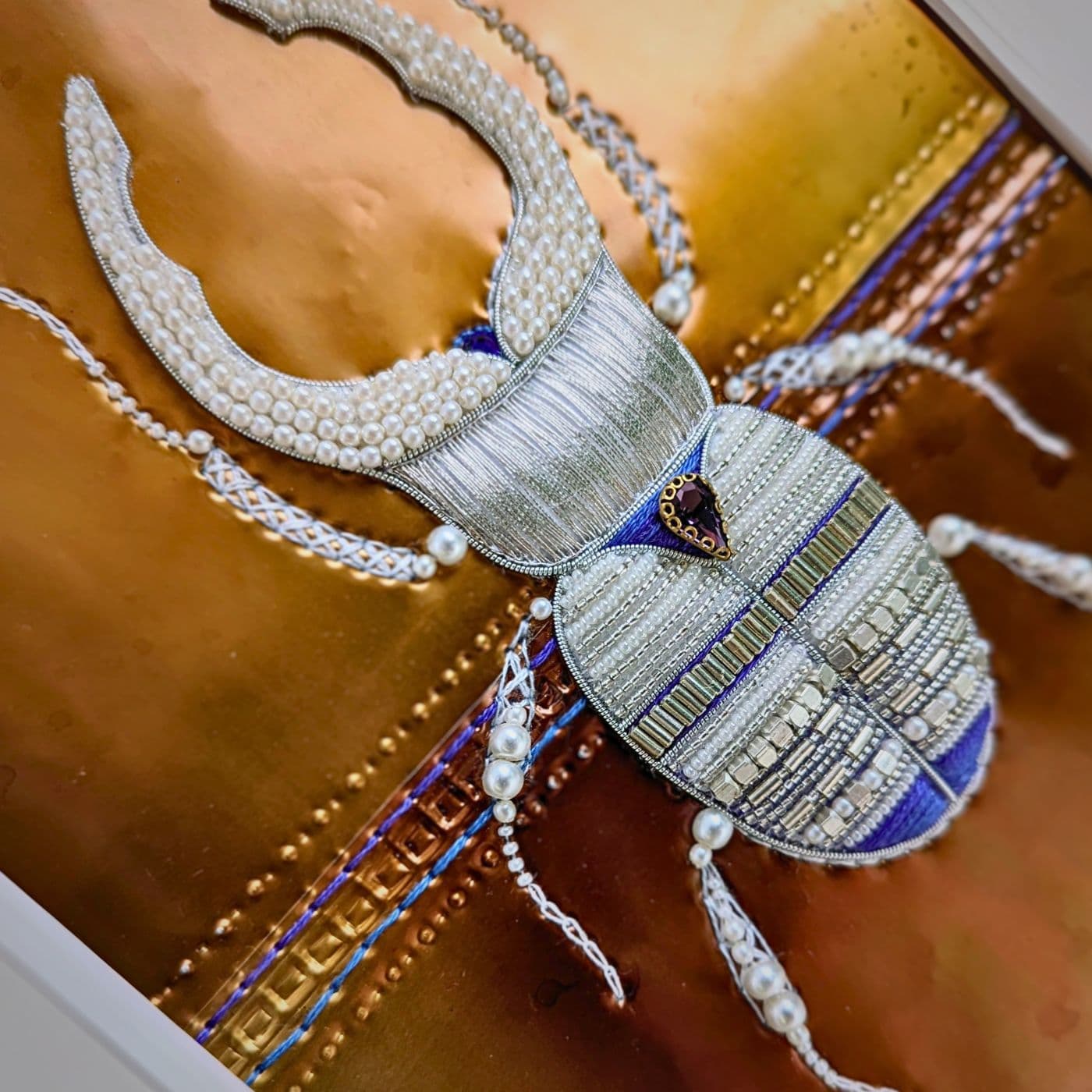
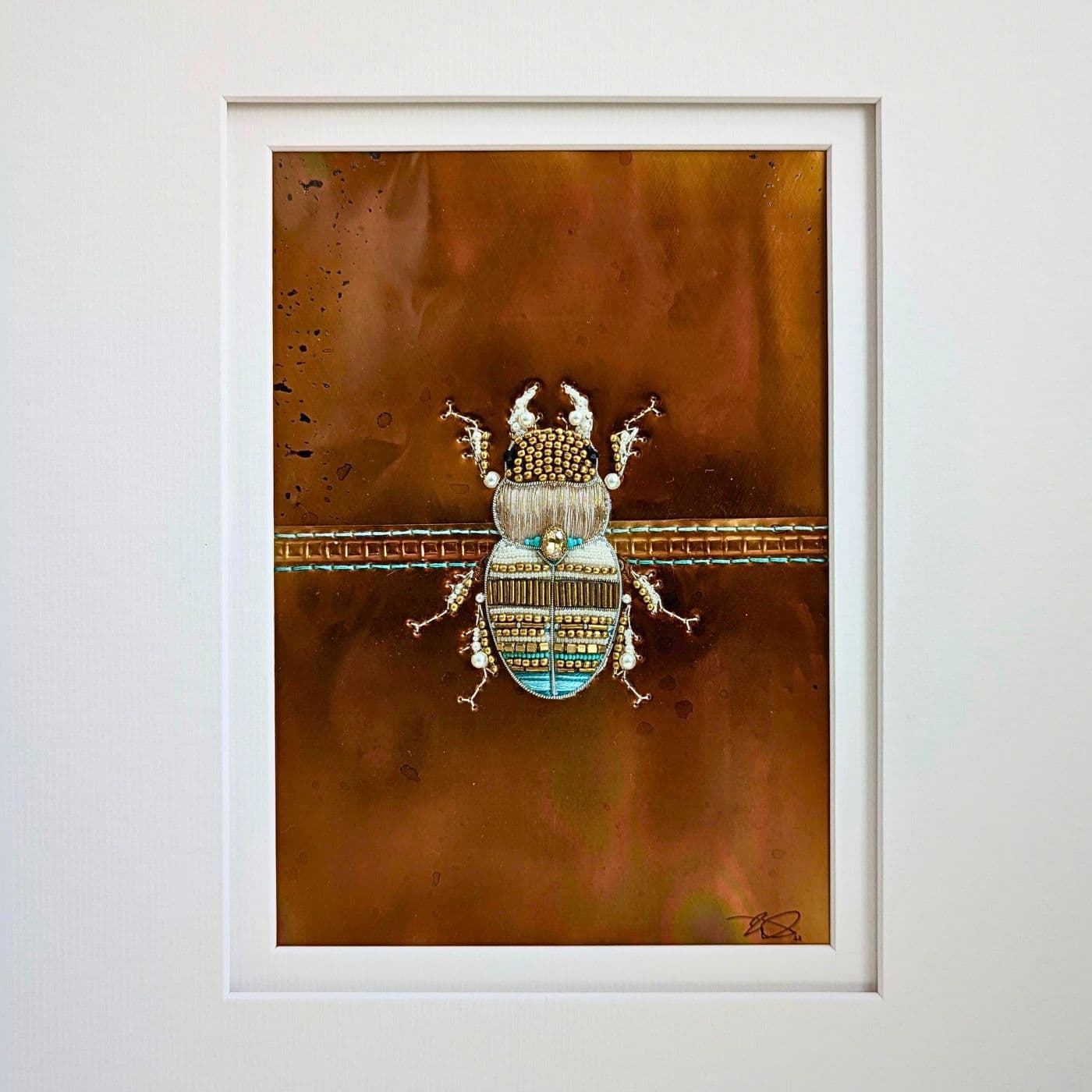
Intrigue, impact & illusion
Tell us about your work exploring intrigue, impact and illusion…
Emma Pannell: I think the intrigue comes from the time when I worked in theatre. When presenting a play or a song, it must entertain and engage an audience.
I started with insects in 2018. They are of constant fascination to me and have symbolic meaning across time and cultures.
While working in the south of France on a creative project in 2022, the opera Die Zauberflöte, an adaptation of The Magic Flute, there were lots of insects around.
I was inspired to design a new collection of insect artworks. I really like French design, and there was something about the opulence of the Renaissance era that I felt would be really interesting to combine with the insects.
“I try to make pieces that are multi-faceted, bold and colourful, and spark curiosity.”
Emma Pannell, Textile artist
In terms of illusion, using recycled drinks cans in the way I do disguises what they are. The speckled gold colour gives the impression of a very old material and can pass for something ancient. It’s just like how stage costumes and jewellery can look luxurious under theatre lights, when in fact a tiara could be made from painted tinfoil and bits of coloured tissue.
I’m very interested in the concept of transformation: reforging rubbish into something new. In my work, a piece of old metal or material can become something fantastical like a scarab beetle or a bejewelled body part.
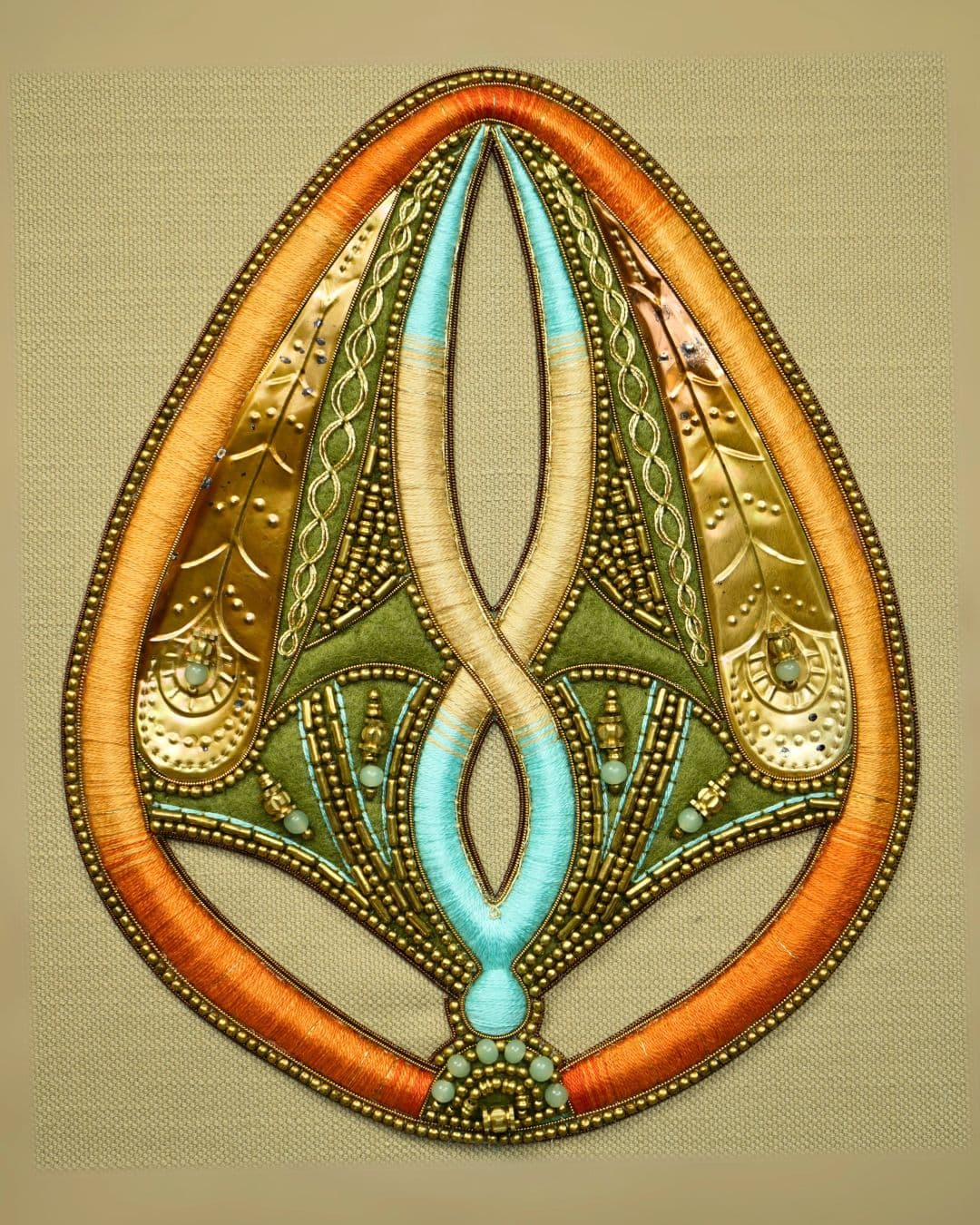
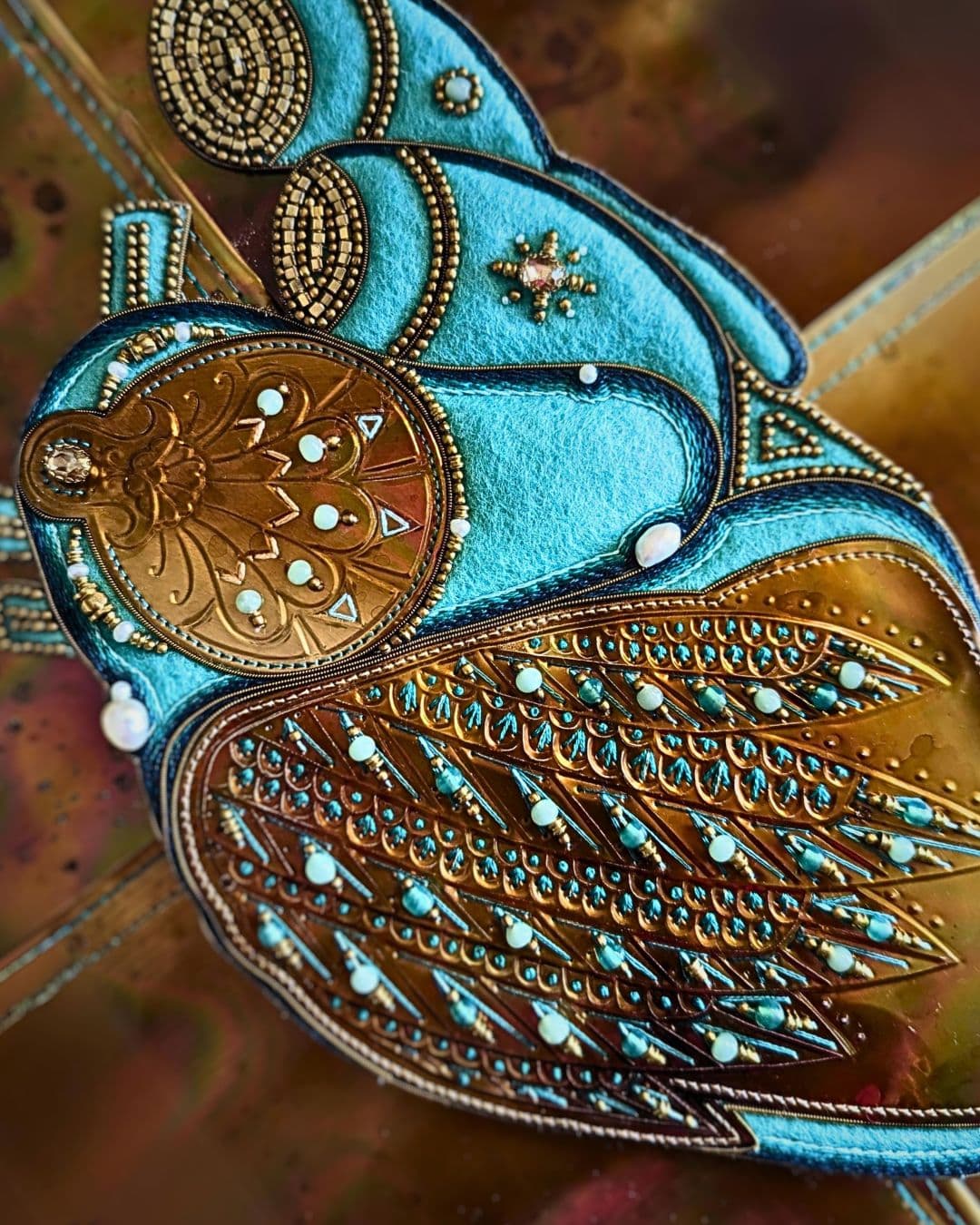
Burnishing & manipulating
What made you decide to work with discarded tin cans?
Before leaving home to study an art foundation course in Lincoln, I was given a box that was my great grandfather’s. It contained tools for metal embossing as well as pieces that he’d made. I was immediately taken with the practice. He’d died before I was born and my family are all very practical people, so it was wonderful to discover I had a creative family member.
The metal material that he used was a combination metal and is no longer in production. I found drinks cans to be a good substitute, although I had to figure out a few things for myself and it wasn’t easy finding the right people to consult.
Initially, I struggled with heating the metal and how to apply the heat to achieve a consistent gold colour across the sheet. It was taking me hours to burnish just a few sheets.
It was my dad who helped me: he had a weed burner in his garage and, as the temperature is easier to control, it enabled me to burnish the cans more evenly and quickly.
Perfecting the process of burnishing and manipulating the metal took over ten years.
“I’m fascinated by just how malleable this material is – it’s surprisingly strong and is easy to sew, while being light as a feather.”
Emma Pannell, Textile artist
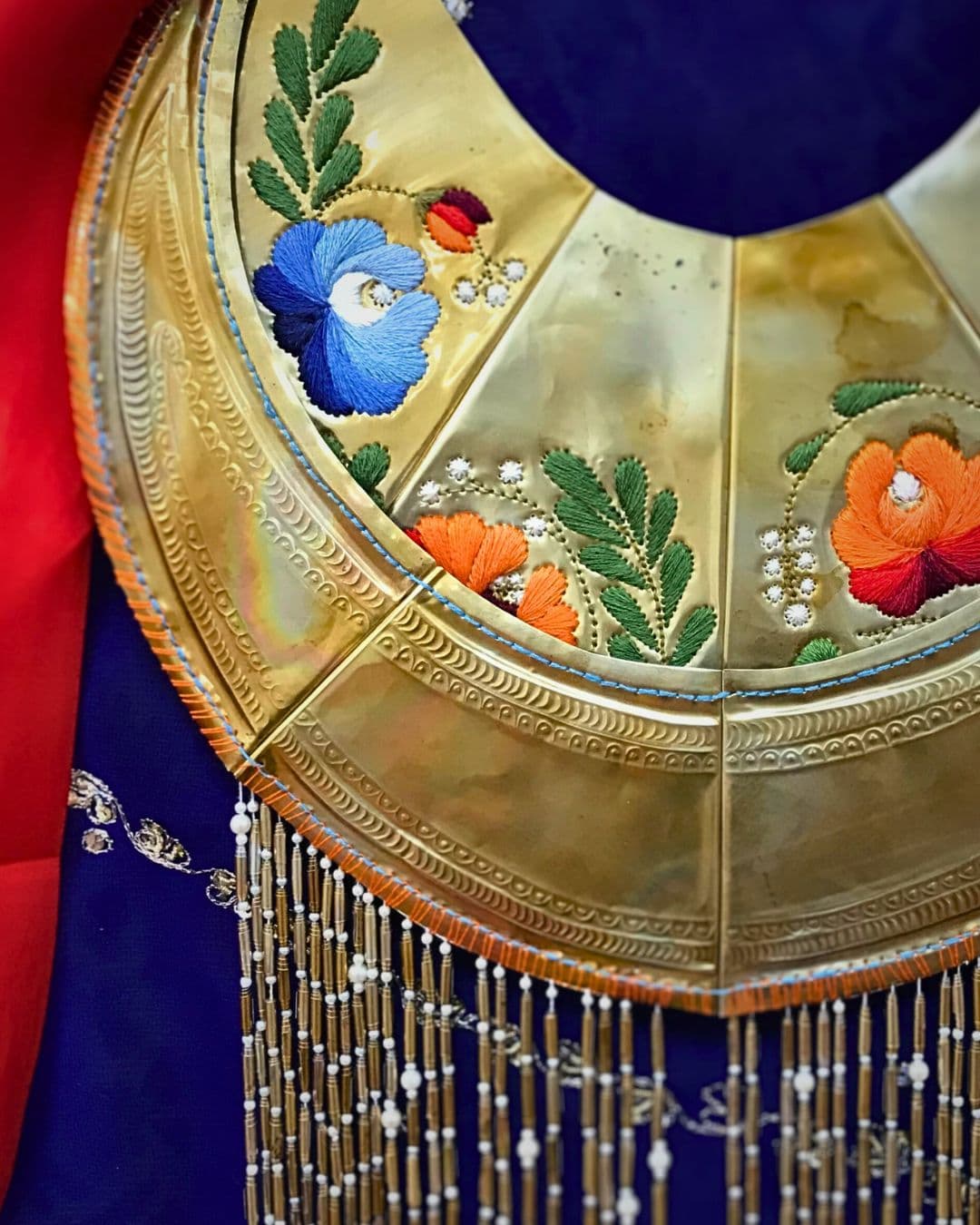
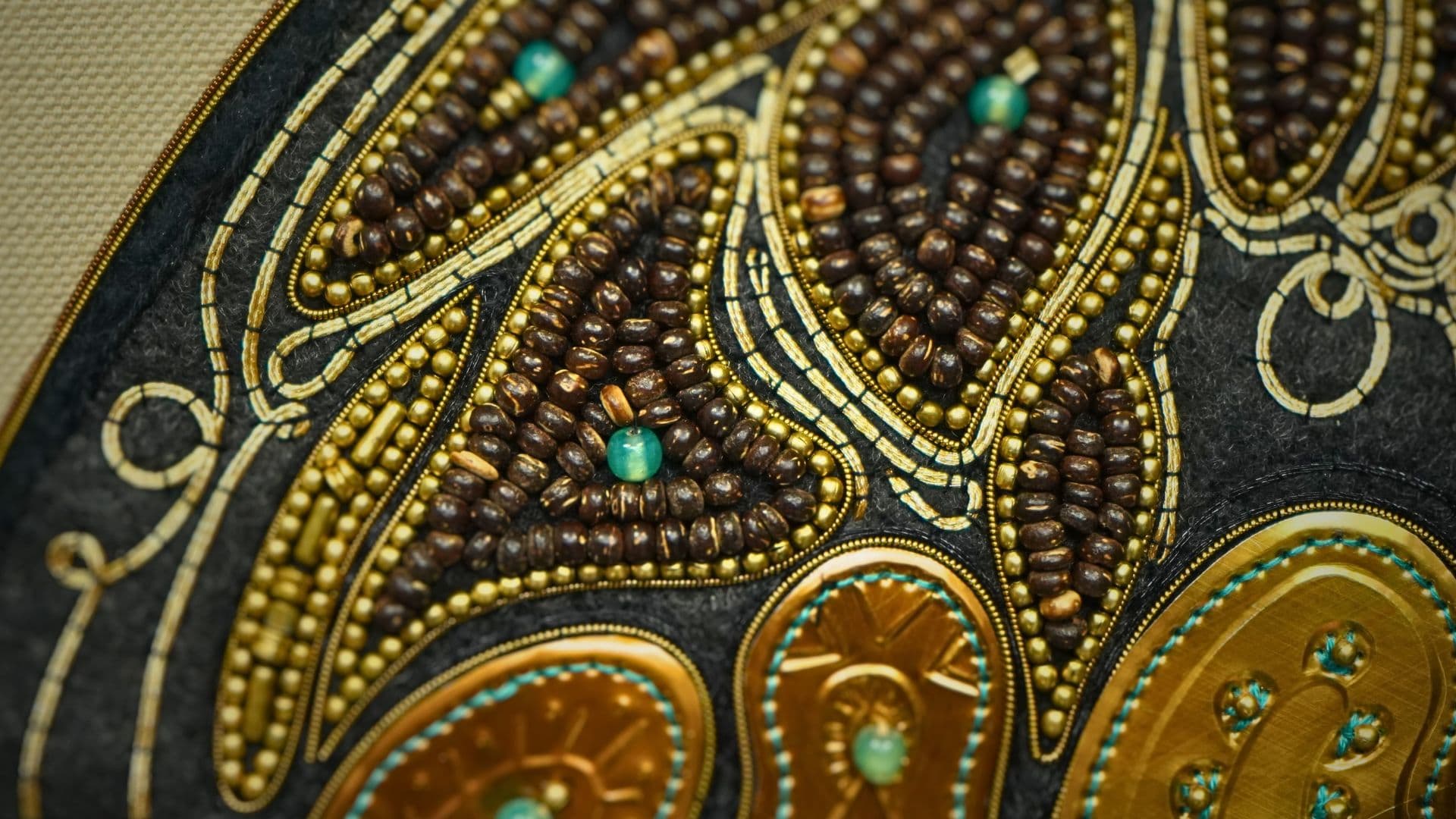
Actor, puppeteer, artist
How did you develop your artistic skills?
My great aunt taught me how to sew, and I did an arts foundation year at the University of Lincoln, but I’m mostly self taught.
I wasn’t quite sure what I wanted to do and had always felt torn between acting and art. When I was studying at Lincoln, my application to progress to a fine art degree course got lost. By the time this was discovered, it was too late and the courses were full.
This left me at a crossroads, so I took a year out. I did some creative work but also applied for drama schools and was accepted onto a course at the University of Salford. While my degree focused on acting, I still ended up doing a lot of making.
I was a pretty hands-on student and ended up painting sets and making puppets. I also did some work in the costume department after taking sewing and garment construction lessons with a fabulous lady, Maureen, who worked there.
I worked as an actor and puppeteer for seven years, doing a lot of theatrical and site-specific work as well. Although I enjoyed the theatre work, I felt like something was missing and took some time out to go travelling. Sporadically, I made art during this time and, despite it feeling like a scary step, I decided to focus more on my art around 2018.
“All of a sudden, I had two solo exhibitions and people were calling me an artist.”
Emma Pannell, Textile artist
Out of the blue, I received news about an exhibition proposal I had made months earlier, confirming they would give me the space to show my work.
At the same time, I was in the south of France working as an intern at a theatre company, the Centre Artistique International Roy Hart. With encouragement from a friend there, I put together a proposal for a site-specific art exhibition Metal Shakespeare: Alive.
It was an immersive exhibition and theatrical piece based around Shakespeare’s characters, which would be displayed across the old château at the centre. My proposal was quickly accepted. After returning to the UK, I took several months off to create work for the exhibitions and then worked ad-hoc office jobs to support myself.
Much later on, I became interested in hand embroidery and goldwork. It took a while, but eventually, I developed a method to imprint designs and sew them onto the metal.
Although I took the long way round, I think the whole process informed my work for the better.
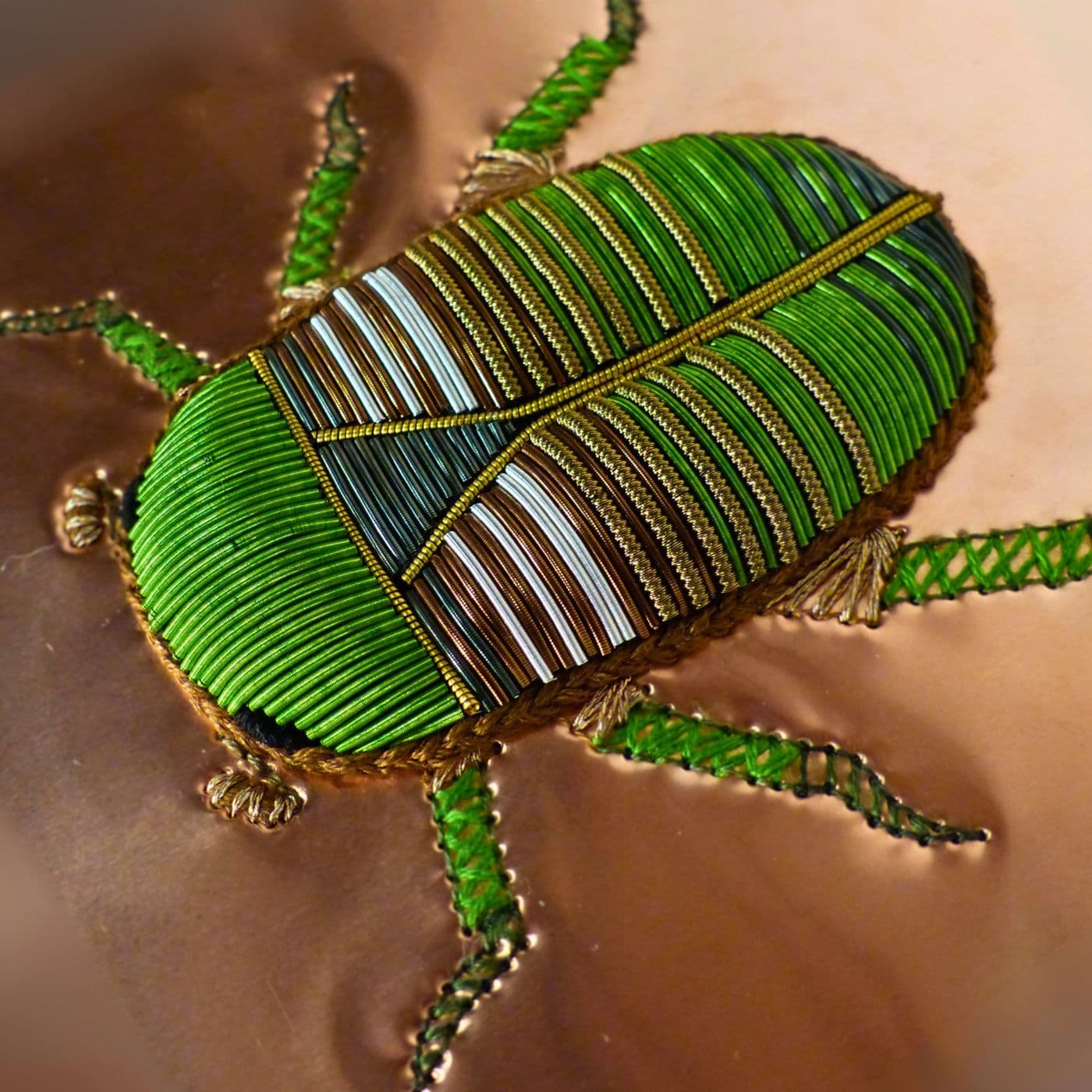
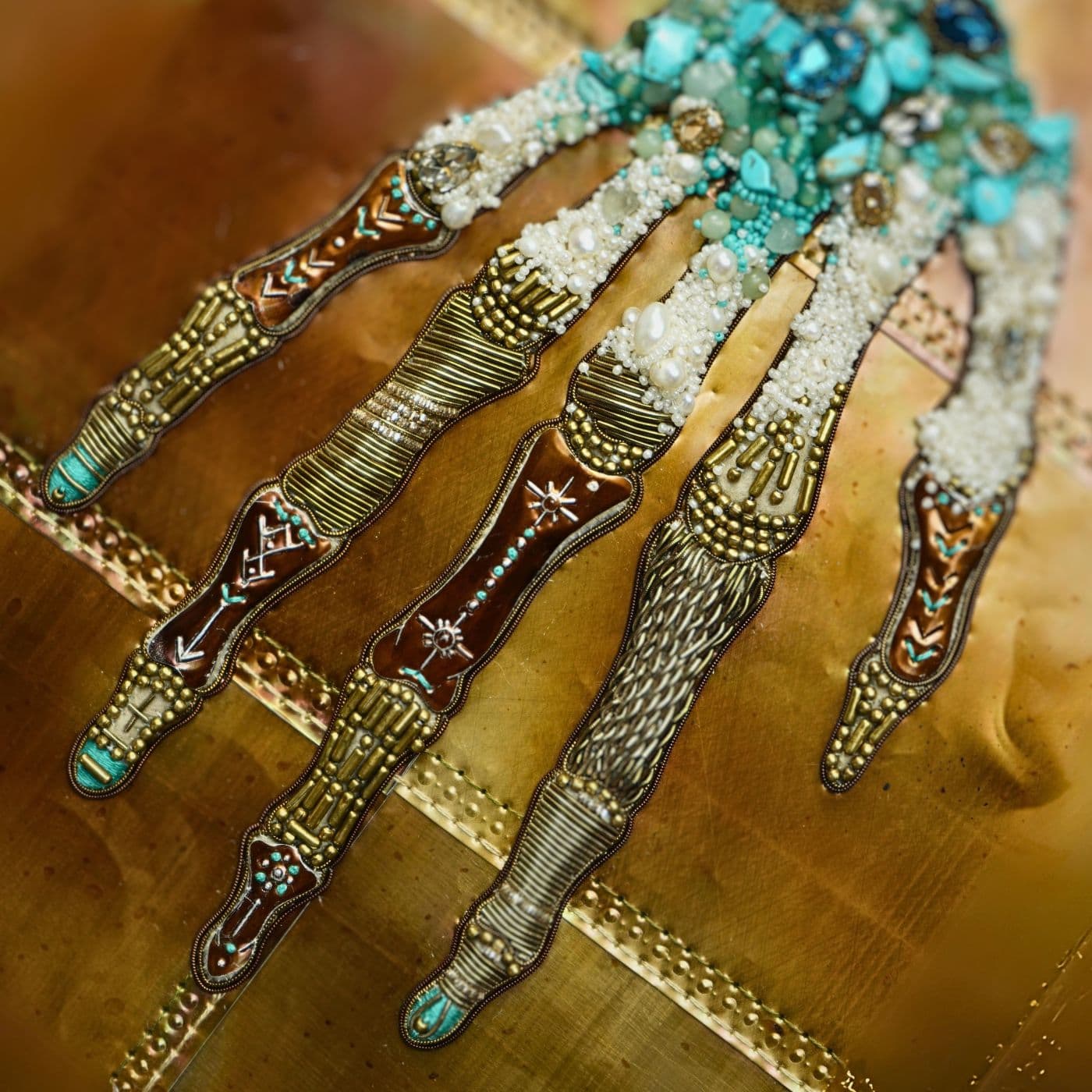
Symmetry & the golden ratio
Tell us more about your process and techniques…
I’ll start with research, gathering a mood board of ideas and what it is I’m trying to realise. Then I create the paper pattern. Sketching is the first stage of preparing work and is integral to making sure the design is right. For my larger pieces, I make a pattern and sew each part together as if it were a garment.
Each new pattern is drafted numerous times to perfect it. Sometimes I will make up to six drafts before it’s ready to be imprinted, or embossed, onto the metal.
If it’s not quite right and is embossed on the metal, there’s no amending it.
“A lot of my pieces reference symmetry and the golden ratio, which I achieve with graph and tracing paper.”
Emma Pannell, Textile artist
I cut the cans, roll them to flatten them and then burnish. Burnishing, or smoking the metal as I like to think of it, changes its colour. This is a tentative process. If the aluminium overheats, it turns a dark silver colour and becomes brittle and unusable.
I then re-cut the sheet, apply the design to the back, hammer and sew it. I hammer the holes using a pottery knife and hammer.
If it’s a three dimensional work, I’ll build the base with felt and outline with purl pearl goldwork wire.
If I’m making a large piece and need to join pieces of metal together, I sew them. Sometimes the sewing joins are on show like Remondé – the Red Beetle or the Ulysses Butterfly. Others have a seam allowance, and are sewn together and pressed down on the inside, like Ophelia: both headpiece and necklace are four cans joined on each side.
For my first sculpture, I made a headpiece (part of Metal Shakespeare) for Tamora, Queen of the Goths, which I superglued, which resulted in a lot of stuck-together fingers.
When I begin to sew the details, even if I’ve made a plan beforehand I’ll quite often improvise as I go. For me, it’s really important to make pieces that are visually interesting, so I include small details that become apparent when looking closer.
I like to use different textured thread, such as matte next to metallic, as they catch the light in different ways. I use varied beading to add contrast and to create intricate designs that are best seen close up.
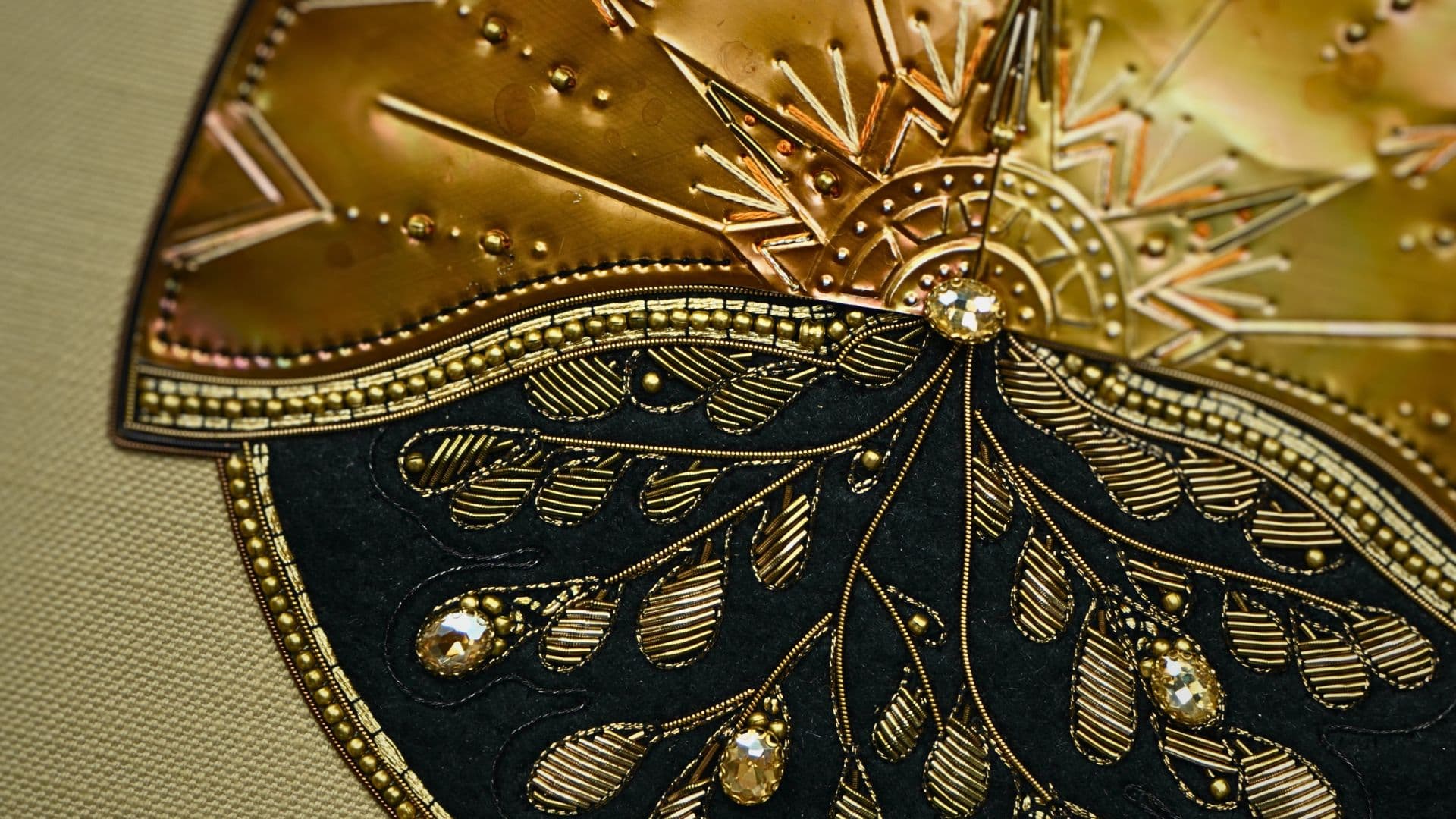
Goldwork & beading
What are your must-have tools or supplies?
I still use my great grandfather’s tools, as well as ones I’ve picked up over the years. These range from pottery, metal embossing, sewing and embroidery tools. I also have some nail art tools which have proven useful. A lot of these I found through craft shops and specialist embroidery sellers.
Because I’m drawn to using texture, I use a lot of goldwork materials such as a finely coiled copper wire which I source from India. This has several different names and can be coiled in a variety of ways to make smooth, matte and twisted effects.
There’s one called nakshi (also called bright check purl). It’s crinkled and creates a glittering element. This one bends like crazy so it can be hard to use in longer lengths, but is really beautiful when cut into small pieces, almost like beads. I like to use a variation of goldwork wires to add depth and texture.
In the last few years, beading has become more prevalent in my work. It’s been an interesting challenge to source beads responsibly. I try to use as little plastic as possible, so the beads I use are brass, ceramic, glass and semi-precious stones, such as freshwater pearl, turquoise and coral. I get a lot from India.
“Where I can, I buy second hand and I’m always on the lookout for jewellery I can repurpose.”
Emma Pannell, Textile artist
These days I use a lot more glass crystals, just through preference and availability. Swarovski jewels appear in my work for special occasions. I might use them for beetles and other animals such as in my work Last Nightingale. The reflection and twinkle of the beads is perfect for creating eyes.
In terms of embroidery silks, I use DMC branded stranded embroidery cotton threads. These are a bit glossier than other brands and better to work with when using the metal.
As our fingertips have a natural oil, this can mark the metal, so when working with copper wires, I wear cotton gloves. I tried using copper sheet metal, but only for a short time, as it was quite fiddly and marked easily.
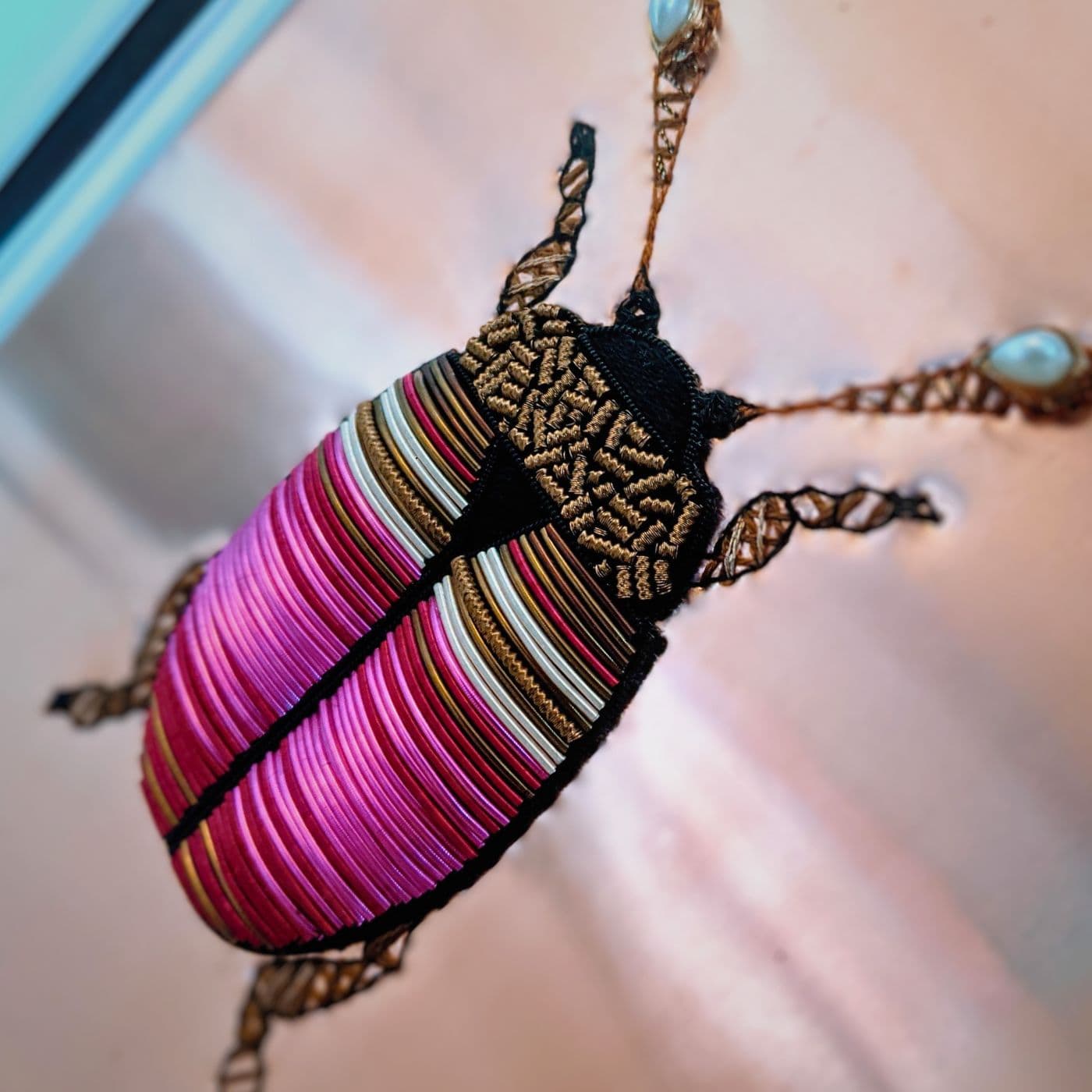
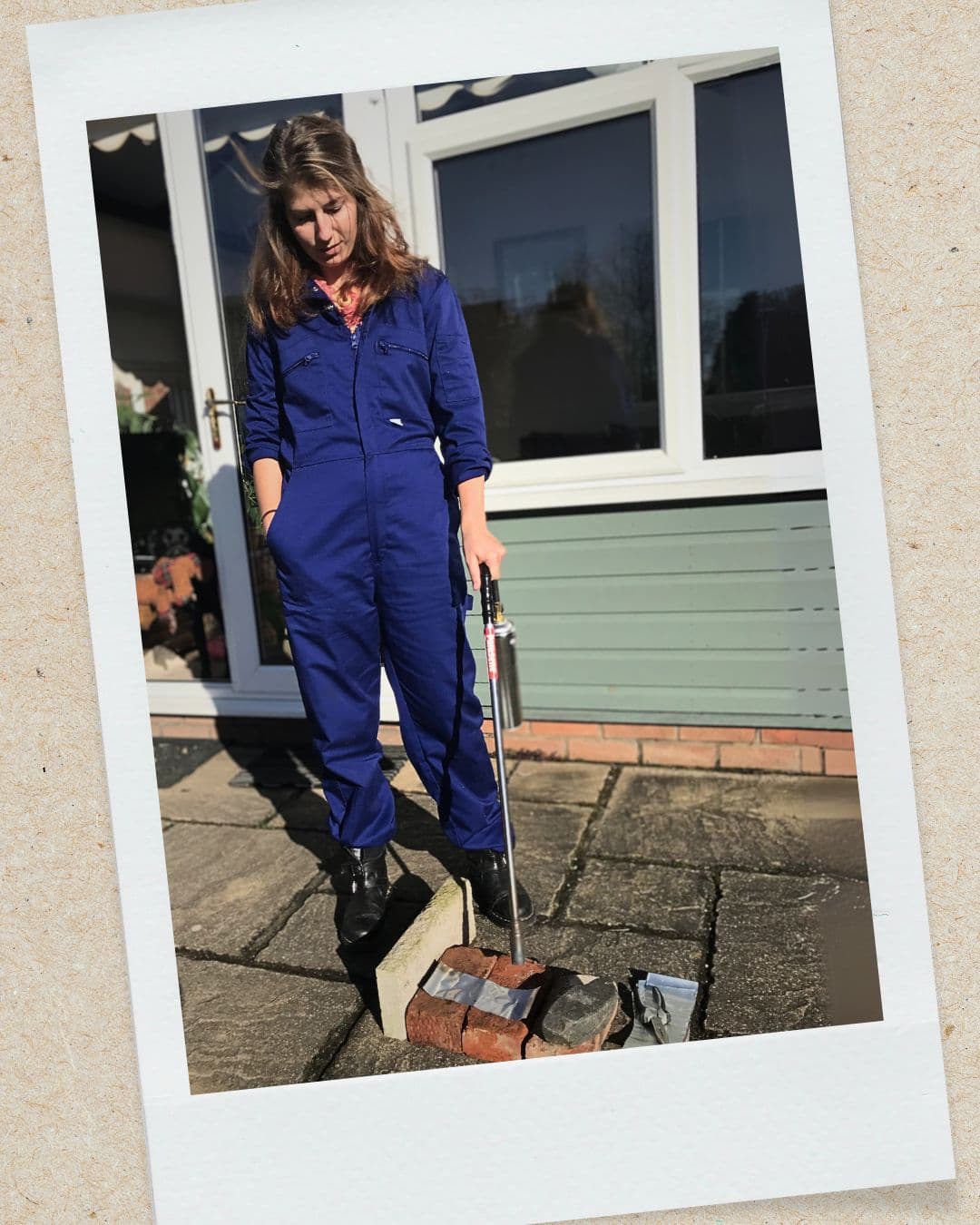
Stitch Club challenges
Tell us about the workshop you created for Stitch Club…
The artworks I made for my workshop are 2D, based on some original pieces inspired by the kingdom of living things.
In the workshop, I share my process for working with recycled aluminium drink cans. Only this type of can has the right level of thickness and flexibility. Admittedly, it’s an unusual material to sew onto, but one that I’ve built my practice around and can’t imagine working without.
“My aim is for Stitch Club members to gain a new skill in working with this alternative material.”
Emma Pannell, Textile artist
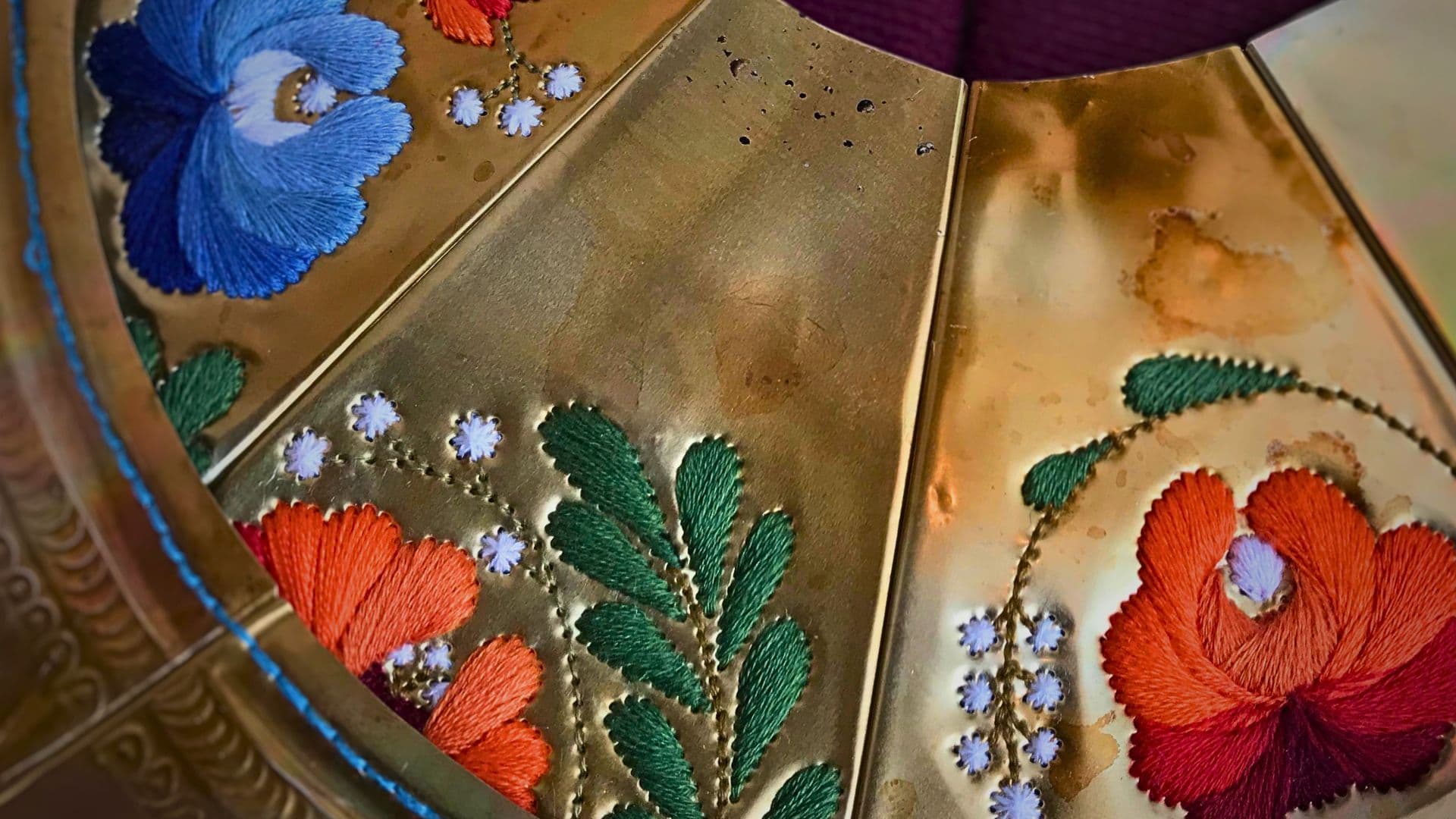
The Last Nightingale
Which piece of your textile art is your most favourite?
Oh, that’s a tricky one! I’ve been lucky to take some of my work overseas. My piece Remondé – Red Pod Beetle was displayed with the work of 67 international artists at the Society for Embroidered Work Surface and Depth Show at Palazzo Velli Expo, for Rome Art Week in 2021. It was part of a dedicated embroidery exhibition celebrating texture.
Although I was not able to be there in person, it was inspiring to discover textile artists who used embroidery in so many diverse ways.
But I think my most favourite artwork would have to be The Last Nightingale which I made for the open exhibition at HOME Manchester in 2022. This referenced The Nightingale by Hans Christian Andersen, a story about a Chinese emperor who falls in love with the nightingale’s song and is gifted a mechanical bird.
I was struck by the fact that, in real life, nightingale birds are experiencing difficulty, as their numbers are currently threatened.
“I wanted to make a piece that reflected the ornate nature of the mechanical bird in the story, but would hopefully make people think.“
Emma Pannell, Textile artist
While making the nightingale piece, I had to sew the two halves of the body separately. It was integral to the piece that these matched up when sewn together. This took careful planning in the pattern making process, as well as double and triple checks while sewing.
The embroidery on the body resembles the bird’s musical nature. I wanted to create a melodic feel to it as if its notes were travelling on the wind, and I was inspired by Art Nouveau and impressionist design for this element.
The wings are made out of metal, and embellished with glass beads and stones. Balancing the weight of these was important as they had to support themselves and not crush the main body.
It was a pleasant surprise to find that when someone walked past the vibrations would make the wings move, as if fluttering.
Although it’s a smaller piece, I’m very fond of it – just as I am of the real bird.
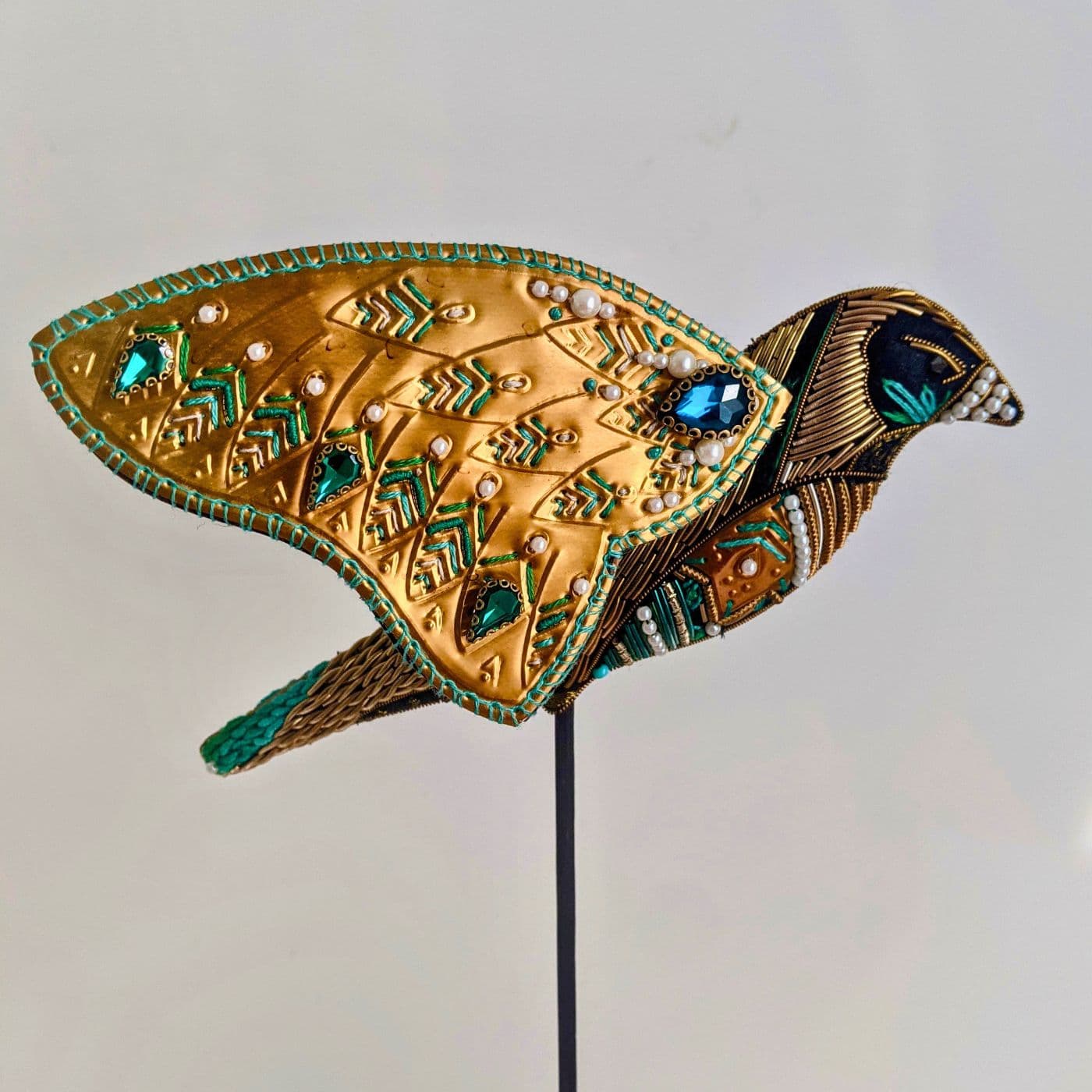
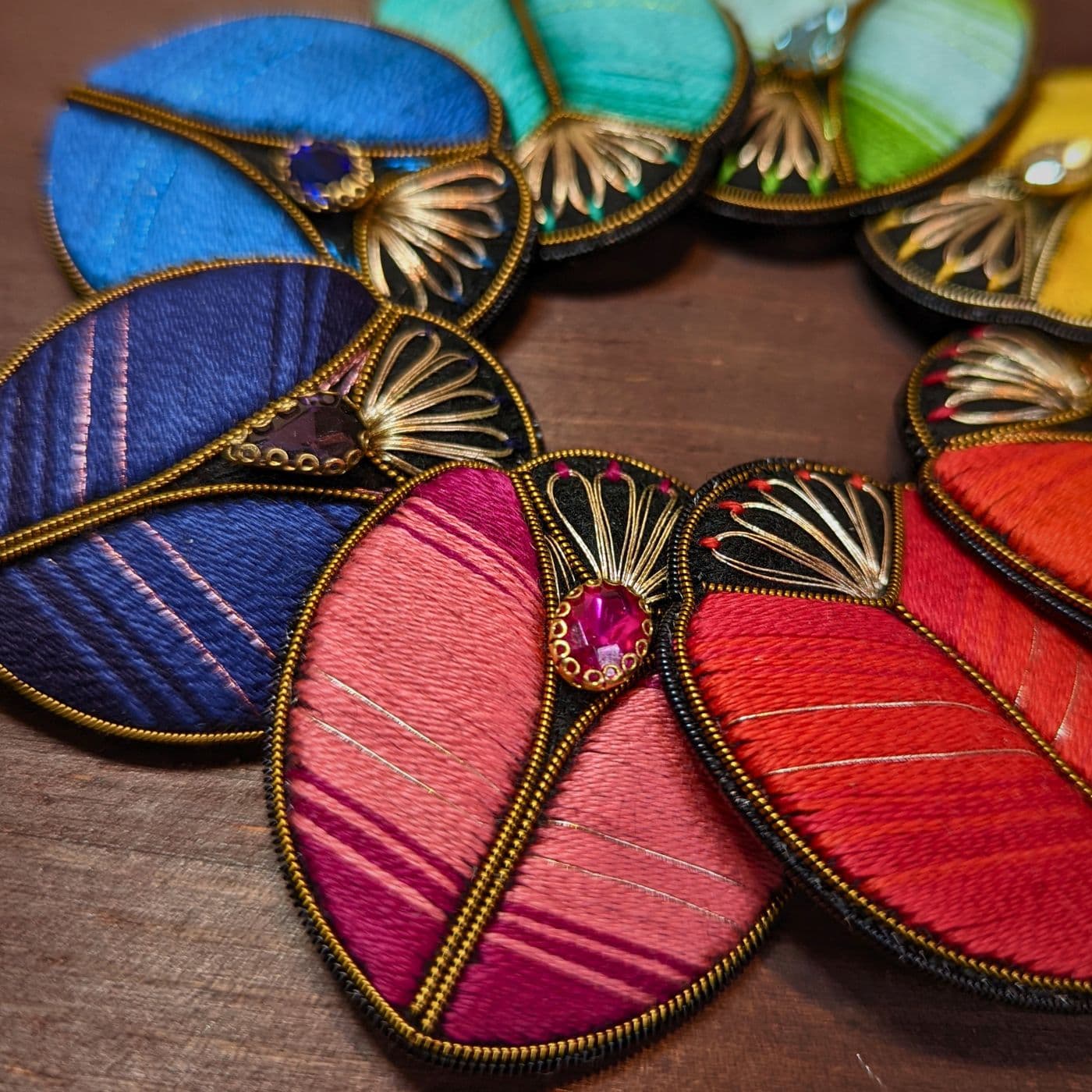
Puzzle pieces
How has your work developed and what direction do you think it will take in the future?
I think my work has become more playful. I learned to embroider on metal, and not fabric, so my early work focused more on shapes and bringing the subjects to life.
As I continue, designs have become more complex and tend to be multi-layered, using metal and material interchangeably to create a completely new surface. Pieces have also grown bigger.
I enjoy setting myself challenges, especially when I’m not quite sure how a piece will fit together. It’s like a puzzle that I have to find the answer to.
My project Art of Anatomy, presented as a work in progress at the Didsbury Parsonage in Manchester in 2024, is inspired by the original illustrations from Gray’s Anatomy medical text. I’m very interested in the jobs that the body does and the many layers that make us.
I’ve examined the idea of belief. Inspired by design and symbology from cultures across the globe (including Egyptian, Ottoman, Amazigh, Indian and Aztec), I purposefully juxtaposed them together. This collection of work aims to re-frame parts of the body as sacred objects.
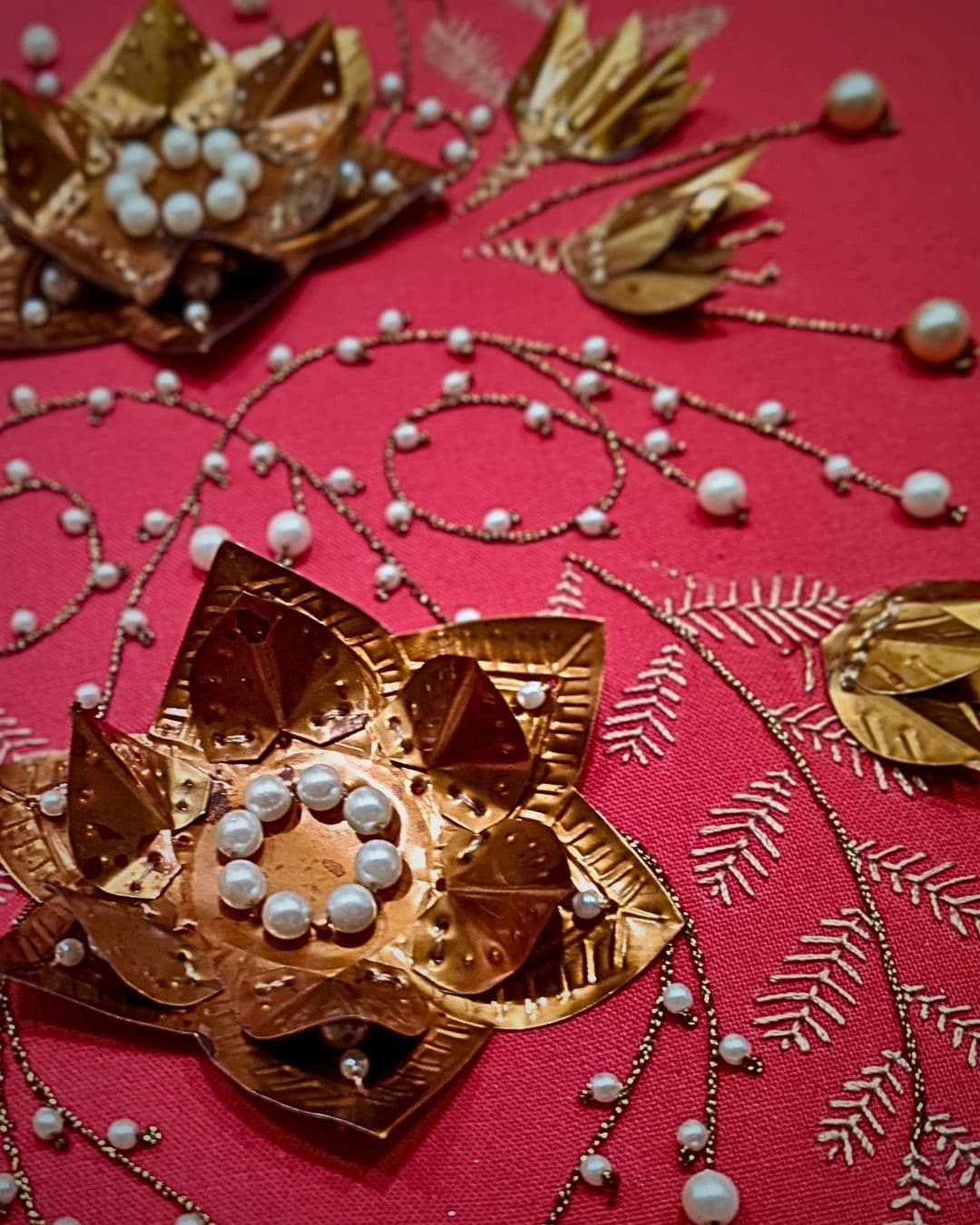
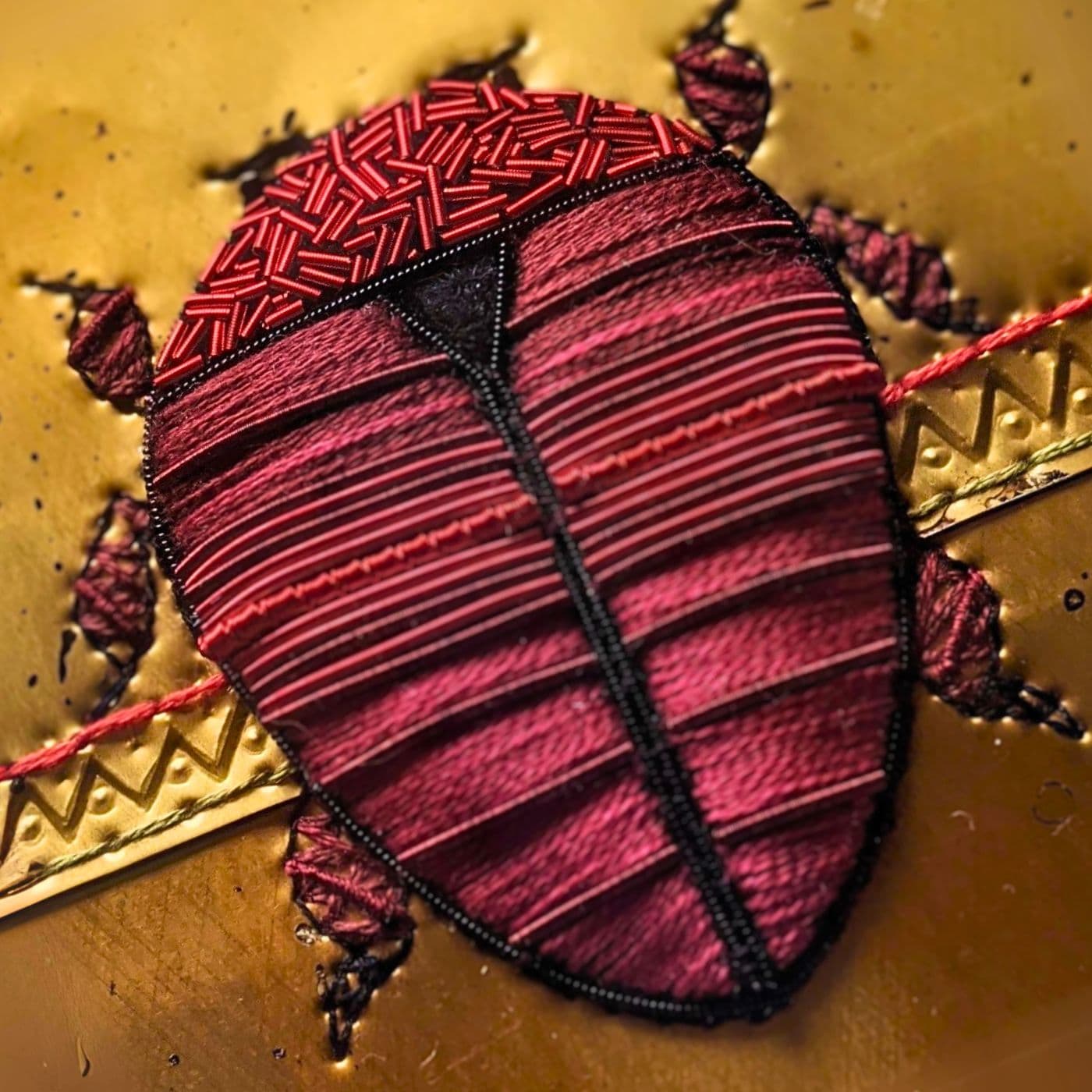
Mistakes & experiments
What advice would you give to an aspiring textile artist?
My advice would be to enjoy playing with the materials and then relish the mistakes.
It’s all a learning curve. I would encourage them to follow their impulses and develop work that inspires them. I watched a lot of YouTube tutorials, read sewing and embroidery books, and made a point of going to specialist exhibitions and museums to see work up close.
“Experimental samples very often don’t look impressive but they are always useful learning points.”
Emma Pannell, Textile artist
Before starting a piece of work, I experiment with sewing techniques and materials.
I have yet to find anyone who works with metal and embroidery in the way I do. In the beginning, this was hard as I had to figure things out for myself, but I also think it got me to where I am today.
Stitched work is such a useful, varied and versatile skill, and can be applied to a myriad of textures and materials. It never ceases to amaze me. To me, embroidery is one of the oldest expressions of art.
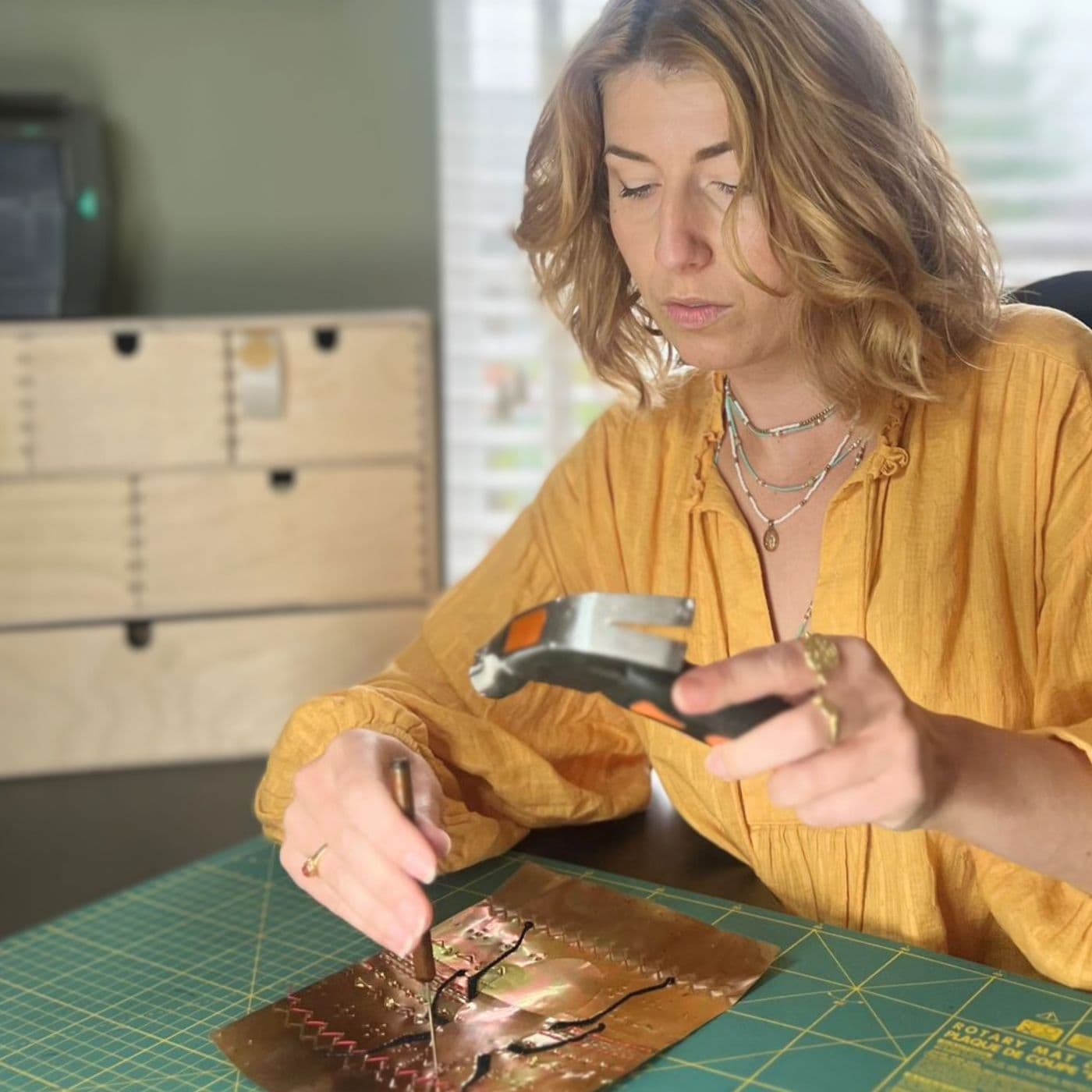
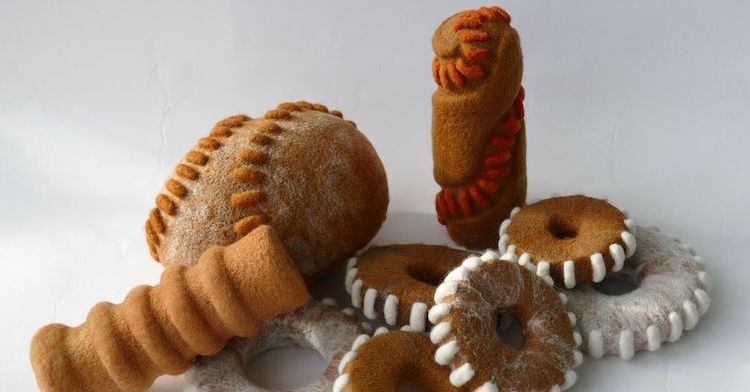
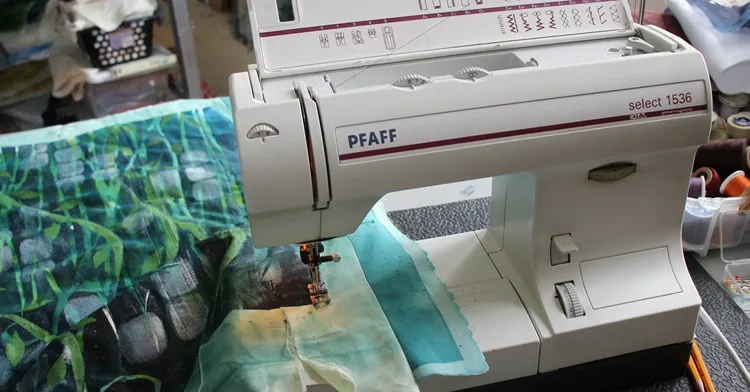
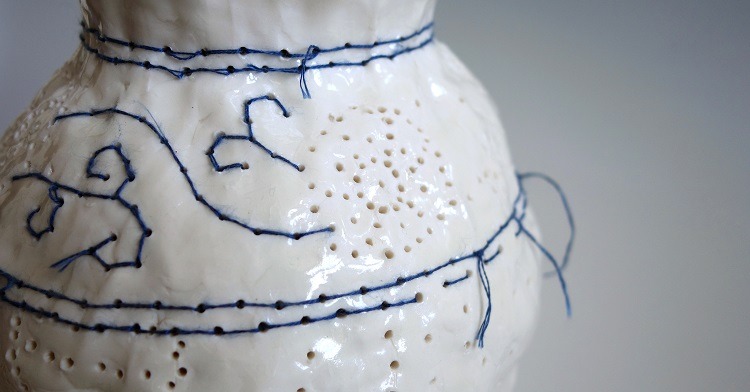
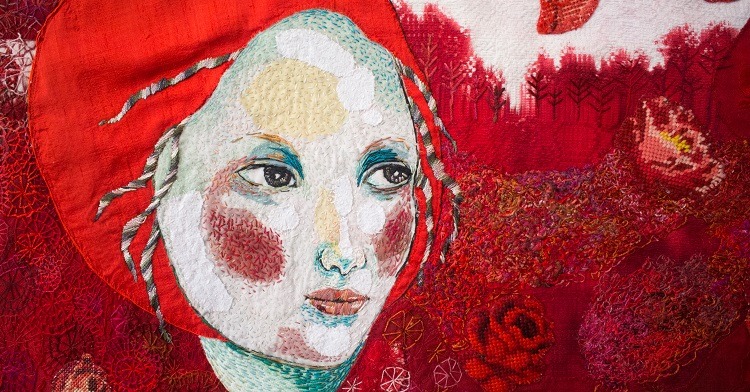
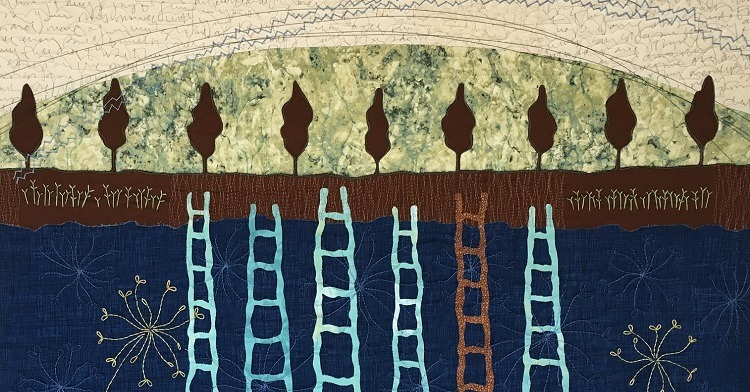
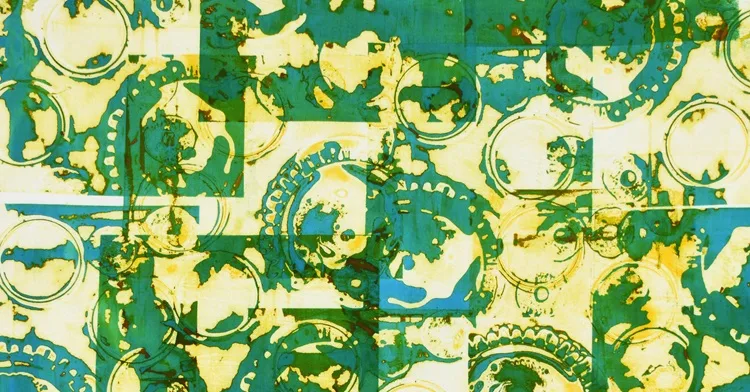
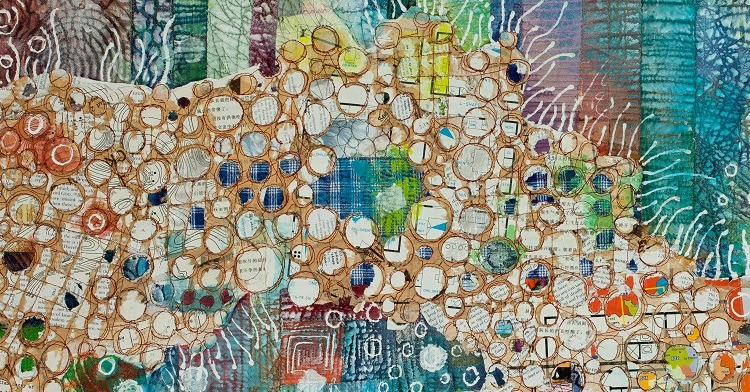
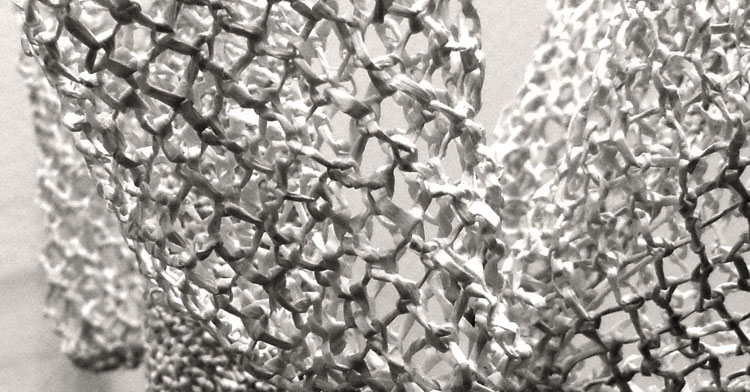
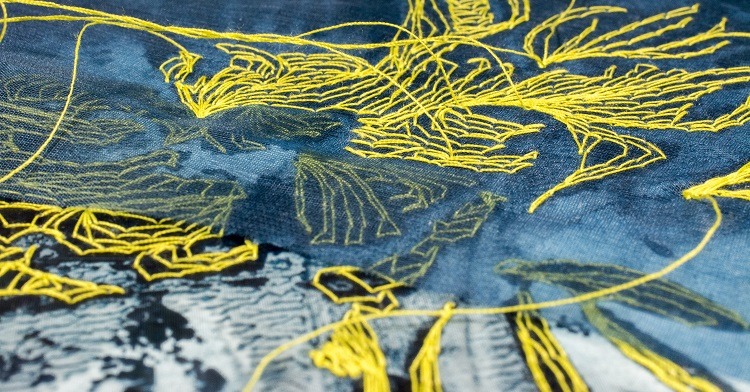
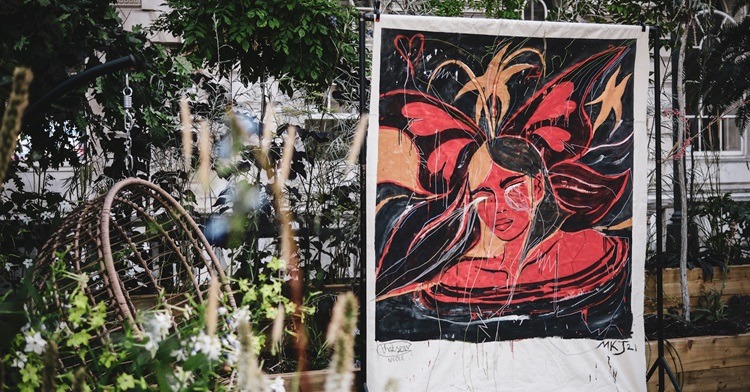
6 comments
Cre8iveskill
What a creative approach to embroidery! Stitching on a tin can is such a unique way to blend texture and form. Love how Emma Pannell pushes the boundaries of traditional embroidery!
Sue Anne Iman
Stunning! When she pokes a hole and stitches through it, what keeps the metal edges from cutting and snagging her thread? She’s so inspiring!
M millard
A joy to behold—truly creative.
Gonca
I found very interesting of using anatomical structures as subjects. Is the artist related with health sciences anyway?
Charlotte
Great suggestion, and thank you for your question! As far as we know, Emma’s work isn’t directly connected to health science, but her creative interpretation of anatomical structures is truly remarkable. We love that you made this connection—thank you so much for sharing your insight!
Donna Woodlands
I found Emma’s work most inspiring, just when I needed some inspiration. I love the shiny, reflective nature of materials and thread used